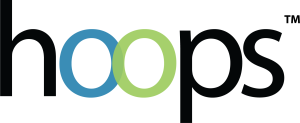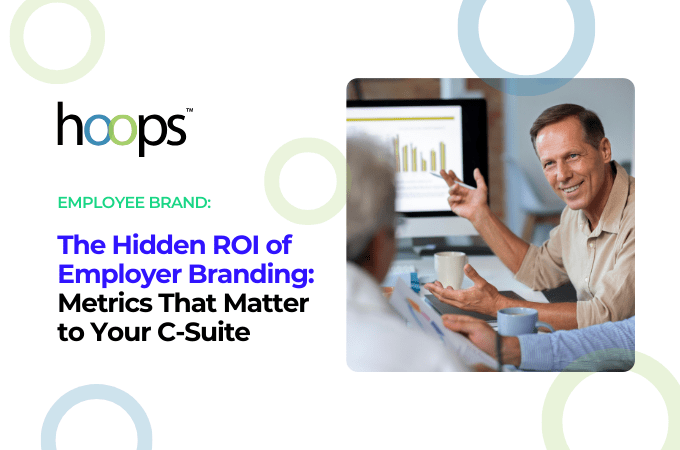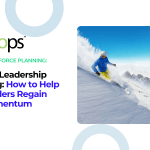If you’re in the C-Suite, you’re used to dashboards that translate effort into results. But one lever still hides in plain sight on most executive scorecards: the ROI of employer branding. Not just how your company looks to candidates—but how consistently your brand is experienced by employees from day one through year five, and how that experience shows up in retention, productivity, customer outcomes, and growth.
At Hoops, we call this ROPI—Return on People Investment. It’s the language that turns culture into numbers, and numbers into decisions. Here’s how to measure it, improve it, and show your board why the ROI of employer branding belongs on next quarter’s agenda.
Quick Math: Your ROPI Equation
Traditional hiring metrics—like cost per hire or time to fill—tell only part of the story.
ROPI takes a wider lens:

“People Investment” means everything it takes to keep your team thriving: salaries, hiring, onboarding, training, benefits, engagement, retention… basically, everything you spend on (well) your people! That distinction highlights the ROI of strategic investments like employer branding.
Most companies aim for 200–300% ROPI, but when the ROI of employer branding is pursued deliberately (consistent story, consistent experience), 400%+ is achievable via lower turnover, faster hiring, less agency reliance, and stronger long‑term performance.
Example: If talent-attributed revenue growth is $5M and your people-related investment is $1.5M, your ROPI is 333%.
The Employer Branding ROI You Can Measure
Leaders don’t fund “nice to have.” They fund levers that compound. The ROI of employer branding compounds in five places you already measure:
- Lower cost to hire & reduced pay pressure
A damaged reputation is expensive. Companies with a poor employer brand pay at least 10% more per hire—a direct tax on growth. Flip that around and a strong brand can pay ~10% less for the same quality, because candidates value the overall experience and future upside. (Harvard Business Review) - Better applicant quality & funnel efficiency
With a stronger talent brand, companies see 50% more qualified applicants, plus faster time to hire and lower cost per hire—reductions material enough to change your quarterly plan. (LinkedIn)
And it’s not just volume; employer brand is twice as likely as overall company brand to drive job consideration—critical if your corporate brand isn’t a household name. (LinkedIn) - Higher offer acceptance
The ROI of employer branding shows up across every touchpoint—from career page to interviews to manager readiness—and it pays off. A positive candidate experience, which begins with your employer brand, is a deciding factor for many: 66% of job applicants say it was the reason they accepted an offer. In our full guide, we break down the exact steps to create this kind of experience—and the metrics to prove it. (SSR) - Stronger retention (your silent P&L line)
Employer brand isn’t just magnetism; it’s glue. Stronger employer brands are associated with a 28% lower turnover rate—meaning fewer backfills, less re‑training, and more continuity on customer‑facing work. (LinkedIn) - Higher revenue growth & market performance
Teams with positive worker sentiment and strong employer brands correlate with higher revenue growth and superior stock returns over time. (TIMES/Charter). LinkedIn’s research also found companies with high brand sentiment grew 20% faster than their lower-branded peers.
The New Reputation Loop
Employer brand is no longer siloed from customer brand. Candidates research you like customers do, and they judge leadership credibility and culture signals the same way.
-
83% of job seekers research reviews and ratings before applying. If they don’t like what they see, they bounce—and so does your ROI of employer branding. (Glassdoor)
-
Your leadership voice and employee experience weigh heavily in how workers perceive your brand—and whether they’ll recommend you. Glassdoor’s recent analysis places employee experience at the center of stay/leave decisions. (Glassdoor)
Monitoring both employee and customer review ecosystems (Glassdoor, Google, Indeed, Yelp/BBB) isn’t extra credit—it’s risk management for the ROI of employer branding.
A CFO-Friendly Scoreboard
If you want to track ROPI in a way that resonates in the boardroom, here are five high-value metrics to watch:
-
Time to Fill – Target: 30–45 day average for non-executive roles (varies by industry).
-
Quality of Hire – 12-month retention + manager performance ≥ 4/5.
-
Offer Acceptance Rate – Strong employer brands: >90%.
-
Voluntary Turnover – Benchmark: <15%; best-in-class: <10%.
-
Applicant Mix & Volume – Track “qualified” ratio; strong brands see 50% more qualified applicants.
Beyond Attraction (Where the ROI of Employer Branding Compounds)
Employer branding isn’t just about filling roles—it shapes the employee lifecycle:
-
Onboarding → time-to-productivity – Aligning onboarding with your EVP and manager playbooks reduces ramp time.
-
Internal mobility & career clarity – Career growth and authentic leadership comms boost retention (TIME/Charter).
-
Manager consistency – Standardized candidate communications ensure no one hiring manager undermines your brand.
-
Employee advocacy – Candidates trust employees 3× more than company messaging (LinkedIn).
Making Employer Branding a C-Suite Priority
For CEOs:
-
Use brand health data in workforce planning and succession planning.
-
Tie branding goals to your 1-, 3-, and 5-year revenue targets.
For COOs:
-
Standardize candidate experience to reflect your culture in every touchpoint.
-
Monitor both employee and customer-facing reviews, since poor customer sentiment can repel top talent.
For CFOs:
-
Factor employer brand impact into cost avoidance models. Lower turnover and faster hiring mean real savings.
-
Treat employer branding as a strategic investment rather than a discretionary cost.
Our full guide walks through the exact actions to hit these milestones and measure the ROI at each stage.
What to Fix First (Fast Wins That Stack ROPI)
-
Close the review gap. Respond to every Glassdoor/Google/Indeed review. Candidates notice; remember that 83% are researching you anyway.
-
Tighten the candidate experience. Clear timelines, prepared interviewers, and proactive updates—small, consistent changes that shorten cycles and improve acceptance.
-
Publish your EVP everywhere. Job ads, career page, onboarding decks, manager guides. If employees can’t see it and leaders can’t teach it, it won’t move the ROI of employer branding.
-
Activate advocacy. Employees > ads for credibility; build the toolkit and recognize participation to amplify the ROI of employer branding.
In our full guide, we show how to operationalize these quick wins for measurable ROPI gains.
Executive Takeaway: Measure Before You Invest
The ROI of employer branding is not a slogan; it’s a system. It lowers the cost of every future hire, increases the velocity of every team, and stabilizes the core of your business—retention. The research is clear: strong employer brands reduce turnover, attract more qualified applicants, close offers faster, and correlate with superior business performance over time.
You wouldn’t launch a new product without knowing the market size. The same applies here—know your current employer brand strength before you start optimizing.
Ready to benchmark your ROI of employer branding?
-
Get a score in 2 minutes with the free Employer Brand Checkup.
-
Then go deeper with our guide: How Employer Branding Drives Revenue Growth—a practical playbook for aligning brand, experience, and ROPI.
Both are free, quick to complete, and designed to give your leadership team data you can act on this quarter!
Build Your Winning Team. Hire and Scale Talent.







